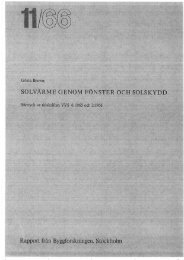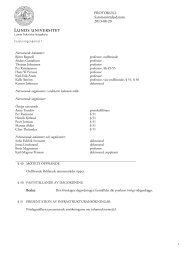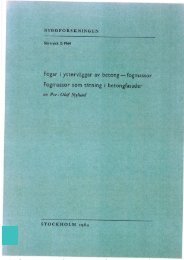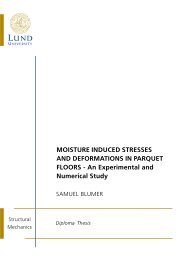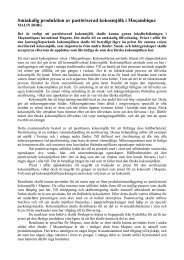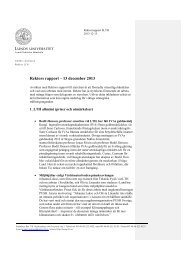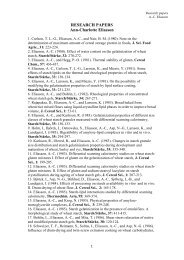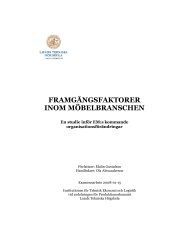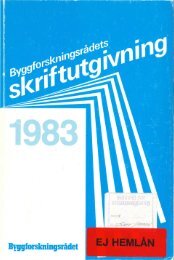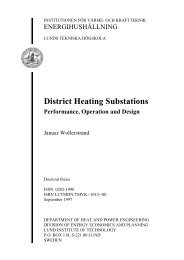LÄRANDE I LTH - Lunds Tekniska Högskola
LÄRANDE I LTH - Lunds Tekniska Högskola
LÄRANDE I LTH - Lunds Tekniska Högskola
You also want an ePaper? Increase the reach of your titles
YUMPU automatically turns print PDFs into web optimized ePapers that Google loves.
Lärande i <strong>LTH</strong><br />
Genombrottet – blad 21 – april 2013<br />
Genombrottet är <strong>LTH</strong>:s pedagogiska stöd- och utvecklingsenhet som bland annat ger högskolepedagogiska<br />
kurser och beforskar undervisning och lärande. Genombrottet bistår också<br />
lärare, programansvariga och <strong>LTH</strong>-ledningen med stöd för undervisningsplanering, undersökningar<br />
och ett ramverk för högskolepedagogisk meritering.<br />
Digitala resurser i undervisningen, flexibelt lärande och lärandesituationen för utländska studenter står i fokus<br />
i aprilnumret av Lärande i <strong>LTH</strong>. I den första artikeln presenterar sig Genombrottets gästprofessor Linda Price,<br />
som forskar och undervisar om användning av digitala resurser inom högre utbildning. Linda Price har vid <strong>LTH</strong><br />
ansvar för kursen ”Supporting Learning through Digital Resources”, som kommer att ges nästa gång hösten<br />
2013. Övriga artiklar är baserade på rapporter skrivna i samband med pedagogiska kurser vid Genombrottet<br />
under 2012. Den första behandlar virtuella lärandemiljöer och hur återkoppling, kamratgranskning och motivation<br />
påverkas av de förutsättningar som råder där. Den andra beskriver hur studentproducerad film som<br />
belyser viktiga grundbegrepp inom arkitekturen kan användas inom undervisningen, samt responsen hos<br />
både de studenter som gjort filmen och de studenter som får ta del av filmen. Den avslutande artikeln tar upp<br />
lärandesituationen för utländska studenter, exempelvis hur fördelningen mellan föreläsningar, grupparbeten<br />
och självstudier uppfattas, samt hur interaktionen mellan lärare och studenter upplevs.<br />
Innehåll<br />
Sid 2: Promoting the use of educational<br />
technology in a way that support student<br />
learning - Visiting professor at Genombrottet<br />
<strong>LTH</strong><br />
Sid 3: Motivation, peer learning and feedback<br />
in flexible learning - Virtual Learning<br />
Environments<br />
Sid 5: Teaching common language in architecture<br />
with short movies - Students producing<br />
audio-visual educational material<br />
Sid 6: Teaching and Learning adaptation<br />
for International students - The case of<br />
Sweden - Teacher and student views on<br />
teaching and learning for international<br />
students<br />
Sid 8: <strong>LTH</strong>:s Högskolepedagogiska kompetensutvecklingskurser<br />
våren 2013<br />
Sid 8: Kom ihåg<br />
Sid 8: Kontaktinformation<br />
<strong>LÄRANDE</strong> I <strong>LTH</strong> - BLAD 21<br />
1
Promoting the use of educational technology in<br />
a way that support student learning<br />
Visiting Professor at Genombrottet <strong>LTH</strong><br />
Linda Price, Genombrottet, <strong>LTH</strong> and Open University, United Kingdom<br />
Who is Linda Price? I am employed in the Institute of Educational<br />
Technology at the Open University, UK, and now<br />
also work as Visiting Professor at <strong>LTH</strong> for 20% during two<br />
years. I have been researching and promoting pedagogically-driven<br />
uses of educational technology in a range of contexts<br />
in higher education for more than 17 years. I use my<br />
research and that of others to foster academic practice that<br />
promotes student-centred learning and engenders scholarly<br />
approaches to teaching and learning. I have led workshops<br />
on this in the UK and abroad. I have worked through the<br />
Carnegie Academy for the Scholarship of Teaching and<br />
Learning (CASTL) with international colleagues on how<br />
to promote scholarly practices in teaching and learning. My<br />
recent research focuses on investigating and developing models<br />
of scholarly practices using technology in learning and<br />
teaching through understanding academics’ conceptions of<br />
and approaches to teaching and learning with technology.<br />
My educational practice also includes teaching in further<br />
education colleges in more vocationally oriented programmes,<br />
i.e. computer programming, and in teaching at a secondary<br />
school in Northern Ireland. This experience has<br />
taught me the importance of context: not just the context<br />
of the institution or the topic of study, but also the student’s<br />
personal context and how one has to be sensitive to this<br />
in the teaching situation as it can influence how well the<br />
student succeeds. The power of education has been particularly<br />
important in Northern Ireland; as people have<br />
become more educated they have become more tolerant of<br />
each other and violence has reduced significantly. I believe<br />
that good education is an important component of any civil<br />
and developing society.<br />
I have also worked in industry. I was a computer programmer/analyst<br />
in industry for a number of years – so I’ve been<br />
in the ‘trenches’ so to speak. My industrial experience gives<br />
me a perspective of what might be expected of graduates<br />
after they leave university and what employers might expect<br />
of them. This has instilled in me a strongly ‘authentic’<br />
approach to assessment in relation to student learning. A<br />
considerable amount of what ’counts’ for assessment and<br />
evaluation of an individual in university, is not always what<br />
‘counts’ in the real world. So assessment strategies at university,<br />
always need to be finely balanced between developing<br />
individuals and in preparing them for the workplace.<br />
This ideal of authentic assessment is one that I am interested<br />
in promoting: it’s valuable for the graduate entering<br />
the workplace and valuable for university’s reputation in<br />
terms of the calibre of student able to adapt quickly and<br />
effectively to the workplace.<br />
I also have four children and this gives me yet another perspective<br />
on education and how technology can be used to<br />
support students. I have two children still at secondary<br />
school and two that have completed their higher education.<br />
Seeing how all my children have used technology in<br />
their various stages of learning provides an insight into how<br />
activities can be interpreted from the learner’s perspective.<br />
This insight has shown me that it is all too easy to make<br />
judgements about the learning activities from a teaching<br />
perspective without really understanding the challenges<br />
that it presents for learners. In a more robust manner, I<br />
research this within my substantive post at the Open University.<br />
I use my research to foreground the student experience<br />
and to give the students a voice. I carry out large<br />
scale quantitative studies and small scale qualitative studies<br />
to investigate how students experience various phenomena,<br />
particularly educational technology, in their programmes<br />
of study. The Open University’s focus on the student experience<br />
has managed to establish it as one of the top universities<br />
in the UK, where the National Student Survey,<br />
administered annually by the government has illustrated<br />
that students have regarded their experience at the Open<br />
University highly. The Open University has been ranked as<br />
the top university for nearly six years in succession. This<br />
is particularly impressive given that it is a distance education<br />
university, with no entry requirements and typically<br />
has around 250,000 students per year. I am proud to be<br />
working at a university that offers a chance for a university<br />
education to students who may not have had the opportunity<br />
to enter higher education at the age of 18, or who may<br />
not have initially gained the appropriate qualifications to<br />
gain entry into a university programme.<br />
So why did I end up as a Visiting Professor at Genombrottet,<br />
<strong>LTH</strong>? <strong>LTH</strong> is particularly highly regarded for its scholarly<br />
approach to academic development and student learning.<br />
It is strongly research-based and uses good evidence<br />
to under-pin its programmes. At conferences I was always<br />
attending presentations held by representatives from Genombrottet<br />
as their research and their ideology was very<br />
close to my own. It was great to be able to exchange research<br />
and ideas about how to improve student learning in<br />
a robust and scholarly way and how we could support our<br />
colleagues in their teaching to help achieve that. I always<br />
thought it would be great to work with these people but<br />
never dreamed that it would happen. Then Roy Andersson<br />
at Genombrottet came to the Open University for an<br />
Erasmus exchange visit and I reciprocated a few months<br />
later. Genombrottet wanted to be able to support colleagues<br />
in using technology in their teaching and learning in a<br />
scholarly way and I had been running workshops and programmes<br />
in this for many years at the Open University. So<br />
this was an ideal opportunity for us all to work together to<br />
exchange ideas, expertise and experiences.<br />
2<br />
<strong>LÄRANDE</strong> I <strong>LTH</strong> - BLAD 21
My ambitions and expectations for my work at <strong>LTH</strong> is that<br />
I want to be able to support the great work that goes on<br />
at Genombrottet and at <strong>LTH</strong> and to be part of a forward<br />
thinking and scholarly unit that develops teaching and learning<br />
in such a thorough, collegiate and thoughtful manner.<br />
I also want to be able to promote the use of educational<br />
technology in a way that actually helps the students in their<br />
learning, where it is not perceived as an added or extra activity<br />
to what they already do. In other words an integrated<br />
activity that helps students achieve their learning goals, or<br />
to quote John Biggs ‘constructively aligned’. A considerable<br />
amount of what I have found through my research is that<br />
technology has been used for the ‘sake of technology’. In<br />
other words it is not clear how it is helping students in their<br />
learning. I have often observed a ‘technology deterministic’<br />
approach to using educational technology. By this I<br />
mean that the use of technology is underpinned by an assumption<br />
that by merely ‘adding’ it, learning will improve<br />
more or less by itself. This tends to result in ‘presentational’<br />
uses of technology, such as better PowerPoint slides, better<br />
quality lecture notes on the internet, or podcasts of faceto-face<br />
lectures, where the focus is on improving teaching.<br />
Research has shown that this leads to passive and less engaging<br />
forms of student learning and does little to enhance<br />
students’ opportunities for development. Instead I would<br />
like to promote more transformational uses of technologies<br />
that engender pedagogically determined use. This aims to<br />
use the technology to develop students, and not the teaching<br />
per se. It supports active engagement of the students<br />
in forms of learning or activities not previously possible. It<br />
also attempts to use the technology to help students develop<br />
skills that they might need in the workplace through<br />
authentic assessment practices. One of the big challenges<br />
of course is in supporting the development of studentcentred<br />
learning practices. This is not about developing<br />
technical skills per se but requires a paradigm shift: from<br />
an instructivist paradigm, where the teacher’s job is to pass<br />
on their knowledge, to a learning (or constructivist) paradigm,<br />
where the focus is on helping the students develop<br />
their own learning, not just now, but in the future too.<br />
One of my main aims in life is to encourage thoughtful,<br />
scholarly, pedagogically driven uses of technology that enables<br />
the collection of good evidence through which sound<br />
judgements can be made about its efficacy in various contexts.<br />
I have been researching the use of educational technology<br />
for many years and my findings, and that of others,<br />
has shown that a considerable amount of technology use<br />
has been aimed at replicating existing practices. The opportunity<br />
to develop more transformational approaches to<br />
using technology is often under-achieved. There appear to<br />
be several reasons for this. One is in relation to conceptions<br />
or beliefs about what teaching is. If a teacher considers<br />
teaching to be about transmitting knowledge to the student<br />
– then that teacher’s use of technology will often result<br />
in replication. Using technology in more transformational<br />
ways is not about developing better skills but in changing<br />
thinking, and I would like to be part of that. However<br />
changing the views of teaching staff alone is not sufficient.<br />
My research has shown that many teachers in higher education<br />
feel constrained by either the dominant teaching paradigm<br />
in the department or faculty, or the surrounding<br />
policies and teaching programmes already in existence.<br />
Promotion criteria too are highly influential in determining<br />
academics’ activities as they influence the value system,<br />
regardless of whether an academic is seeking promotion<br />
or not. Hence there is work to be done at policy level<br />
and with senior managers in illustrating the significance of<br />
their policies in determining actions, some of which might<br />
be unintended.<br />
This is important if we are to impact on student learning<br />
in a positive and developmental manner. Students in the<br />
future will no longer be judged merely on the body on<br />
knowledge that they leave university with, but upon how<br />
well they are able to find information and develop answers<br />
and solutions to problems in the future. In order to do this<br />
they will need to know how to use technology to find appropriate<br />
information, be able to discern its value, discuss<br />
this with other peers in their field and develop appropriate<br />
solutions. They will need to have developed independent<br />
learning skills in finding and developing solutions. So my<br />
overall life aim would be to work across the various levels<br />
of the university stratosphere in order to change minds and<br />
cultures towards more student-centred learning that employs<br />
technology to develop students who can operate in a<br />
global and uncertain world in the future.<br />
Motivation, peer learning and feedback in<br />
flexible learning<br />
Virtual Learning Environments<br />
Andreas Larsson, Bitte Rydeman and Per-Olof Hedvall, Department of Design Sciences, <strong>LTH</strong><br />
Flexible learning is designed to provide learners with increased<br />
choice, convenience and personalisation. In Virtual<br />
Learning Environments (VLEs), what students – and<br />
their teachers – actually do can differ quite widely from<br />
a more traditional classroom context. At the Department<br />
of Design Sciences, we took a closer look at two courses<br />
that rely entirely on VLEs to see how the concepts of feedback,<br />
peer learning and motivation play out under these<br />
flexible circumstances. Both courses in our study; “Design<br />
of Everyday Cognitive Support” and “Use of Digital Pictu-<br />
<strong>LÄRANDE</strong> I <strong>LTH</strong> - BLAD 21<br />
3
es in Healthcare. Schools and Social Services” are elective<br />
courses at the Department of Design Sciences at Lund University.<br />
All activity in these two courses takes place online<br />
within a VLE called Moodle.<br />
One of the key concepts of constructive alignment is that<br />
students construct meaning from what they do to learn<br />
(Biggs, 1999). However, taking into account Laurillard’s<br />
(2002, p.55) view that “action without feedback is completely<br />
unproductive for a learner”, we must also pay close<br />
attention to the ways in which student action is connected<br />
to feedback from both peers and teachers. In many learning<br />
situations, there is a tendency to focus on the feedback<br />
that teachers give to their students. However, feedback can<br />
also be provided by fellow students, by computers, by books<br />
and other agents. Apart from insufficient teacher resources<br />
to provide feedback to students, many students have difficulties<br />
understanding what their teachers really mean, and<br />
they often lack specific advice on how to improve.<br />
Relevant to this challenge is the concept of dialogic feedback<br />
cycles (Beaumont, O’Doherty, & Shannon, 2008),<br />
where interpretations are shared, meanings negotiated and<br />
expectations clarified in an interactive exchange. For example,<br />
teachers could use two-stage assignments to motivate<br />
students to engage in peer learning (Boud, 1999) with<br />
the teacher as a coach and a facilitator rather than as an<br />
authority. Peer learning involves “people from similar social<br />
groupings who are not professional teachers helping each<br />
other to learn and learning themselves by so doing.” (Boud,<br />
1999) A key challenge when aiming at peer learning is that<br />
peers are not domain experts, as opposed to teachers, which<br />
means that the accuracy of peer feedback can vary greatly.<br />
Feedback from peers may be partially correct, fully incorrect<br />
or misleading (Gielen et al, 2010). Further, since a peer<br />
is usually not regarded as a “knowledge authority”, students<br />
can be reluctant to accept judgement or advice made by a<br />
peer (Gielen et al, 2010). Interestingly, there are some potential<br />
benefits following from these considerations. For<br />
example, the absence of an obvious “knowledge authority”<br />
(e.g., a teacher) implies that students need to be mindful<br />
about the accuracy of the feedback they receive, inducing<br />
discussions and reflections about the interpretation.<br />
Since the studied courses only took place online, the students<br />
never met in person, apart from some students who<br />
themselves arranged a meeting with other students who lived<br />
nearby. The students thus had some flexibility in choosing<br />
when, where and how to interact with students and<br />
teachers. However, even if all students had the possibility<br />
to interact with the other students and the teachers through<br />
the forums, there were huge differences between the students<br />
regarding how much they took advantage of this opportunity.<br />
Some students attended both these courses, and<br />
one such student started an interesting discussion in one of<br />
the courses, noting that she liked the fact that the students<br />
could see each other’s texts in one of the courses, and she<br />
suggested that it ought to be like that in the other course,<br />
too, so that they could learn from each other. The student<br />
stated, that despite the fact that the students were different<br />
and worked in different ways, they often seemed to come<br />
across the same problems. She concluded: “Sometimes other<br />
thought paths are needed to open new possibilities and<br />
I think you would get that if you had the opportunity to<br />
study each other’s texts.”<br />
There were several written assignments in both courses,<br />
which the students had to send to the teacher or post in the<br />
forums. The teachers gave written feedback to the students<br />
on each assignment, and this feedback included suggestions<br />
about what the students needed to do to improve. This kind<br />
of feedback was given to the students individually and was<br />
usually not visible in the forums, so although it had the<br />
desired qualities (Hattie & Timperley, 2007; Corneli &<br />
Mikrovannidis, 2011) it did not benefit the whole group.<br />
In the forums for learning, two forums stand out, in which<br />
there was a high amount of feedback between the students.<br />
In these forums it was mandatory to comment on the other<br />
students’ posts. For students to be willing to take the extra<br />
step to give feedback, doing so must to be useful for the<br />
students (Corneli & Mikrovannidis, 2011). One suggestion<br />
is to create more assignments or exercises that help the students<br />
analyse and reflect both their own work and that of<br />
others. For example, one of the authors introduced a “feedforward”<br />
exercise in one of his classes, where student teams<br />
were asked to, first, comment and reflect on advantages and<br />
drawbacks of another team’s mid-project presentation and,<br />
second, provide suggestions on how to take the project forward.<br />
This served the dual purpose of allowing students to<br />
give feedback on the past performance of their peers and,<br />
most importantly, use the feedforward technique to help<br />
the other team improve their performance in the forthcoming<br />
stages of their project. While mandatory assignments<br />
are mainly about extrinsic motivation, it still seems like<br />
intrinsic motivation increases when you have personal experience<br />
from feedback cycles that work – and perhaps we<br />
need to introduce mandatory feedback/feedforward cycles<br />
among peers early on in the courses, to create a sustainable<br />
“feedback culture”? In the feedforward example above,<br />
students reported that they felt that it was very useful to<br />
discuss and reflect on their projects with peers that could<br />
relate closely to what they were experiencing at the time.<br />
This relates to the observation – in the two courses we studied<br />
– that many students wished to see their teachers and<br />
fellow students and talk to them, instead of just writing.<br />
In the future, some assignments could be created as group<br />
assignments, where the participants can see and talk to<br />
each other virtually or arrange to meet in person if they<br />
get to participate with one or two students who live nearby.<br />
Another way is to plan a couple of audio conferences<br />
(e.g. Skype or similar) where the students can ask questions<br />
and bring up subjects that they find hard to write about,<br />
receiving advice from both students and teachers. Regardless<br />
of the specific formats that could be used to facilitate<br />
interactive exchange among peers, we have found that it<br />
is useful to rethink the ways in which teachers introduce<br />
feedback mechanisms in both physical and virtual learning<br />
environments, and the roles that students can play in<br />
their peers’ learning process. A teacher could increasingly<br />
take on the role as facilitator of knowledge creation in a<br />
highly dynamic and social setting, as opposed to taking<br />
the traditional role as the “provider” of knowledge. Most<br />
likely, doing so would also help create a collaborative lear-<br />
4<br />
<strong>LÄRANDE</strong> I <strong>LTH</strong> - BLAD 21
ning culture where students put a higher value on the interpretations<br />
and suggestions of their peers, and where they<br />
realize to a greater extent that the most important learning<br />
experiences are those that happen outside of the classroom.<br />
In virtual learning environments, this realization is even<br />
more important, considering that questions, answers and<br />
reflections can be shared rather effortlessly at any hour of<br />
the day, from any location.<br />
References<br />
Beaumont, C., M. O’Doherty, and Shannon, L. 2008. Staff and student perceptions<br />
of feedback quality in the context of widening participation. Research report.<br />
York: Higher Education Academy. http://www.heacademy.ac.uk/assets/documents/research/Beaumont_Final_Report.pdf<br />
(accessed April 10, 2012).<br />
Biggs, J. 1999. Teaching for quality learning at University. St Edmundsbury Press,<br />
Suffolk.<br />
Boud, D., Cohen, R., and Sampson, J. 1999. Peer learning and assessment. Assessment<br />
& Evaluation in Higher Education, 24(4), 413-426.<br />
Corneli, J., and Mikroyannidis, A. (2011). Personalised Peer-Supported Learning:<br />
The Peer-to-Peer Learning Environment (P2PLE). Digital Education Review,<br />
(20), 14–23. Retrieved from http://greav.ub.edu/der/index.php/der/article/view-<br />
File/188/330<br />
Gielen, S., Peeters, E., Dochy, F., Onghena, P. and Stuyven, K. 2010. Improving<br />
the effectiveness of peer feedback for learning. Learning and instruction, 20, pp.<br />
304-315.<br />
Hattie, J. and Timperley, H. 2007. The Power of Feedback. Review of Educational<br />
Research, Vol. 77, No. 1, pp. 81-112.<br />
Laurillard, D. 2002. Rethinking University Teaching: a conversational framework<br />
for the effective use of learning technologies. 2nd ed. London: Routledge.<br />
Teaching common language in architecture<br />
with short movies<br />
Students producing audio-visual educational material<br />
Delphine Bard, Engineering Acoustics, <strong>LTH</strong>, Tina-Henriette Kristiansen, Architecture, <strong>LTH</strong> and Eva Frühwald<br />
Hansson, Structural Engineering, <strong>LTH</strong><br />
At the school of Architecture, Lund University, courses<br />
are taught in different ways. A large part of the education<br />
during year one and two is held as “studios”, doing creative<br />
(individual) project work, with helping teachers always<br />
available for supporting the students. Smaller courses, as<br />
the “technical courses”, rather correspond to the traditional<br />
engineering education style, using lectures, exercises, small<br />
project works (in larger groups) and final written examination.<br />
The problem is that many students are not able to fully<br />
assimilate the content from the technical courses and don’t<br />
know how they should make use of the gathered information<br />
in their creative project works. They also have difficulties<br />
in talking about their project works, as they are lacking<br />
a common architectural language.<br />
The aim of the study was to improve upon the existing<br />
teaching/learning scheme by introducing new methodologies.<br />
As such, it is about teaching common architectural<br />
language and tools to first and second year architectural<br />
students at <strong>LTH</strong>. We strive to teach our students the concepts<br />
of sound, form, light, color and construction, all orbiting<br />
around the common denominator of the architecture,<br />
see Figure 1. The aspect of communication is very essential<br />
Figure 1: Common architectural language and tools.<br />
to the work of an architect and it should be given a central<br />
role in the teaching experience. Each and every student<br />
should have a very good understanding of the basic concepts<br />
and techniques that underlie the field of study, and<br />
this independently from their initial academic and personal<br />
background.<br />
In order to achieve our goal, we gave the students two different<br />
assignments: In the first assignment, the students<br />
had to produce short educational movies (several different<br />
topics, such as structure, acoustics, hierarchy, etc.) to explain<br />
and teach their topic to their peers. A strong emphasis<br />
had to be put on conveying the message clearly to the fellow<br />
students, to make it easy for them to understand. By<br />
working on this objective, they should create a common<br />
understanding and language. Having the students working<br />
in groups on this kind of assignment has several benefits.<br />
First of all, the students really engage into the activity. They<br />
have to rely on themselves and their friends for the work to<br />
be done. And more importantly still, their friends count on<br />
them for doing the tasks they have been assigned to. This<br />
responsibility means that they cannot afford to be passive.<br />
They have to work actively towards their objective. Having<br />
to produce an educational material implies that the students<br />
have to understand clearly the content of their production<br />
beforehand. If there are flaws in the comprehension<br />
of the topic, they will inevitably be laid bare during the<br />
production of the video, when there is still the possibility<br />
to dig deeper into the topic, to discuss and research until an<br />
appropriate level of understanding has been reached. The<br />
teacher, meanwhile, also benefits from the process. Our<br />
hypothesis is here that the assignment implies mutually<br />
helping each other, so the teacher is less likely to have to<br />
explain all the content of the course material down to the<br />
very basics, as more experienced students will take over the<br />
task to help the more inexperienced of their peers.<br />
<strong>LÄRANDE</strong> I <strong>LTH</strong> - BLAD 21<br />
5
In the second assignment, they should implement the new<br />
knowledge gathered in the first assignment into their individual<br />
creative projects. The topic was the remodeling of an<br />
existing building into students living units. The students<br />
should focus on three topics: structure, acoustics and one<br />
more topic of their choice from the movies, see figure 2.<br />
The results from the second assignment showed that the<br />
students who normally would be at a higher taxonomy level<br />
also seemed to integrate an implementation of the gained<br />
knowledge from the first assignment. There was also a very<br />
clear difference between first and second year students, besides<br />
a few exceptions. It seemed like the first year students,<br />
who were not trained in the creative process, had enough<br />
to do with understanding the assignment, getting an idea<br />
about how to turn their ideas into images, and tended to<br />
forget about the implementation of acoustics and construction.<br />
Only a very few of the first year students addressed<br />
acoustics issues in their projects. There was a very clear new<br />
focus on light and its quality, however, which had not been<br />
addressed before at this level. In addition, light construction<br />
was addressed in more projects.<br />
In conclusion, most students produced really impressive<br />
movies and everybody liked this assignment. However, the<br />
implementation into the individual creative projects was not<br />
equally good, as most students had not included thoughts<br />
about acoustics and structure, two essential topics. Only<br />
the very best students, mostly from the second year, really<br />
improved and reached a higher level of understanding when<br />
assessing their level before and after the second assignment.<br />
Figure 2: Basic topics in architecture to be implemented in the<br />
creative assignment.<br />
Teaching and Learning adaptation for<br />
International students - The case of Sweden<br />
Teacher and student views on teaching and learning for international students<br />
D. Bard & J. Negreira, Engineering Acoustics, <strong>LTH</strong>, A. Pazirandeh, Industrial Management and Logistics, <strong>LTH</strong>,<br />
V. Sohrabpour, Packaging Logistics, <strong>LTH</strong> and J. Zhang. Environmental and Energy Systems Studies, <strong>LTH</strong><br />
Every year the number of international students increases<br />
worldwide. Moreover, the number of international students<br />
in western universities has drastically increased in the last<br />
four decades. For the newcomer students, the change of<br />
country includes new challenges and difficulties such as having<br />
to deal with different culture and people in the host<br />
country. Social and psychological factors that facilitate<br />
adaptation to the host country environment have been under<br />
focus of many international researches during the last<br />
ten years. Lack of such adaptation mechanisms, could hamper<br />
learning objectives. Both teaching and learning could<br />
employ methods to facilitate the adaptation to a higher<br />
degree. Although there were 31,000 international students<br />
registered in Sweden in the academic year 2007/2008 still<br />
not much research in this area has been done. Hence, this<br />
investigation attempts to tackle the lack of studies in this<br />
area by investigating learning and teaching adaptations for<br />
international students in the higher education system in<br />
Sweden.<br />
We used a mixed-method with the intention to combine<br />
both teacher and student views on teaching and learning<br />
for international students. A survey with a semi-open questionnaire<br />
was used to capture international student perspectives<br />
(74 in total), and 11 semi-structured interviews were<br />
conducted to capture teachers’ perspectives. The interviews<br />
with the teachers were carried out face-to-face whilst the<br />
inquiries to the students were sent via Internet by means of<br />
an electronic survey. It should be noted that the results are<br />
not intended to come to generalization, but rather an indication<br />
of problems. In fact, cultural generalization among<br />
students could potentially hinder the teaching and learning<br />
process and thus pre-perception should be avoided.<br />
In the survey, it was found that international students perceived<br />
the Swedish students more proficient in the English<br />
language. They also found it difficult to interact with Swedish<br />
students and to integrate with the culture (e.g. in finding<br />
friends). There was a general opinion between South<br />
European students that they had a broader theoretical background<br />
than the average Swedish student. They perceived<br />
the Swedish educational system more practical-oriented;<br />
i.e. in contrast to other countries, where learning might be<br />
based solely from lectures, focus is on group works and self-<br />
6<br />
<strong>LÄRANDE</strong> I <strong>LTH</strong> - BLAD 21
study exercises. Overall, International students thought<br />
that Swedish students are more focused, organized, formal,<br />
serious and interested, making them more competitive,<br />
productive and effective during their studies and in their<br />
future career. Respondents perceived the Swedish students<br />
to have better knowledge of the education system. They<br />
also perceived the Swedish students to normally be more<br />
participative in class.<br />
Also, almost all participants mentioned the informal student-teacher<br />
relationship. The authors argue that idealization<br />
of the teacher-student interaction could be dangerous<br />
in the sense that it could be hiding underlying teaching and<br />
learning problems. Kindness, politeness, help and proximity,<br />
do not necessarily imply a correct pedagogical attitude,<br />
although it may help. Furthermore, one should be careful<br />
as this protective behavior could even turn into a lack of<br />
critical feedback to students.<br />
At the same time, we found that teachers detect several of<br />
these challenges while oversee the cultural adaptation challenges<br />
such as not finding friends, not learning the Swedish<br />
language, and all the factors that impact their integration<br />
within the Swedish norms and daily life. Language barriers,<br />
knowledge of the education system (expectations,<br />
norms, etc.), developing Swedish-International dynamics<br />
among students, and differences in student-teacher relation<br />
norms were found to be important factors that could prevent<br />
effective knowledge transfer.<br />
One point mentioned by teachers as a challenge in adapting<br />
to international students but not mentioned by the<br />
students, was cultural, political, and religious sensitivities.<br />
We interpreted this in three ways: 1) that the awareness of<br />
teachers has been effective, 2) that this is not perceived as<br />
an issue by students, or 3) that students find this issue too<br />
sensitive to mention. This could however, prevent inter-cultural<br />
learning within class. One suggestion is for teachers to<br />
actively use the cultural differences in teaching to further<br />
encourage and develop a forum for inter-cultural leanings.<br />
From these findings in our empirical study, we found that<br />
the international students face both cultural and academic<br />
shock. The relevant adaptation methods followed both by<br />
teachers and students were positive in most cases. This<br />
further improves the one-way adaptation model into twoways.<br />
Actions such as: group work to create a social interactive<br />
play, as referred in the sociocultural theory, is crucial to<br />
promote critical thinking in class and is already a norm in<br />
Sweden. Efforts from both students and teachers to remove<br />
the language barriers are also found in our case study, as it<br />
is an important motivation for cross-border studies. However,<br />
embedding different culture to reach a mutual learning<br />
goal is another question. Many measures taken are still perceived<br />
as seeing international students as “problems”, rather<br />
than the “bearer of cultures”. It still occurs for example,<br />
that classes are separated between the locals and international<br />
students. This neglect could potentially hinder the learning<br />
from both sides, since we could understand ourselves<br />
better, just by looking at others.<br />
The authors: Jingjing Zhang (top left), Juan Negreira Montero (top right), Ala Pazirandeh (bottom left), Delphine Bard (bottom<br />
middle) and Vahid Sohrabpour (bottom right).<br />
<strong>LÄRANDE</strong> I <strong>LTH</strong> - BLAD 21<br />
7
<strong>LTH</strong>:s Högskolepedagogiska<br />
kompetensutvecklingskurser våren 2013<br />
Nedan ges information om vårens återstående kurser. Förutom<br />
de allmänna högskolepedagogiska översiktskurserna<br />
erbjuds även mer praktiknära kurser samt individuella<br />
fördjupningskurser med förhoppningen att kunna möta<br />
intressemångfalden bland <strong>LTH</strong>:s lärare. För utförligare information<br />
(kurstider, datum, med mera) hänvisas till Genombrottets<br />
hemsida http://www.lth.se/genombrottet, där<br />
det också finns information om kurser av andra kursgivare<br />
öppna för <strong>LTH</strong>-lärare.<br />
Introduction to Teaching and Learning in Higher<br />
Education (2v)<br />
As a PhD student or a new teacher at <strong>LTH</strong> you are invited<br />
to Introduction to Teaching and Learning in Higher Education<br />
(this course is equivalent to the course Högskolepedagogisk<br />
introduktionskurs but given in english). Introduction<br />
to Teaching and Learning in Higher Education is<br />
an elective course of the qualifying programme in teaching<br />
and learning in higher education and of third-cycle education<br />
at <strong>LTH</strong>. The course provides an overview of teaching<br />
and learning in higher education and is intended for lecturers<br />
with little or no higher education teacher training<br />
and for doctoral students who teach or are about to assume<br />
teaching duties. The course introduces you to current concepts<br />
of teaching and learning in higher education in order<br />
to develop your ability to improve student learning. It also<br />
provides an introduction for your further professional development<br />
as a university teacher. The course is focused on<br />
students and their situation including students with special<br />
needs, the role of the teacher and his/her professional development,<br />
learning as a cognitive process, different teaching<br />
methods and their effect on students’ learning, assessment<br />
and its impact on students’ learning, evaluation at different<br />
levels, communication and pedagogical qualifications for<br />
teachers in higher education. Last day to register April 28<br />
2013, course start May 27 2013.<br />
Kom ihåg<br />
<strong>Lunds</strong> universitets fjärde utvecklingskonferens - Att skriva<br />
för att leva, lära och lyckas, 24 oktober 2013. Under årets<br />
konferens lyfter vi fram skrivandets och skrivprocessens<br />
betydelse i lärande, förståelse och kommunikation av egen<br />
kompetens. Dagen utgör en möjlighet till dialog, inspiration<br />
och kritisk diskussion om lärande, undervisning och<br />
lärarskap. Konferensen arrangeras i samverkan mellan<br />
<strong>Lunds</strong> universitets områden/fakulteter. Som värd för årets<br />
konferens står Naturvetenskapliga fakulteten. Deadline för<br />
bidrag till konferensen är 1 maj 2013, sista anmälningsdag<br />
är 12 oktober 2013. http://utvecklingskonferens13.se/<br />
4:e Utvecklingskonferensen för Sveriges ingenjörsutbildningar,<br />
<strong>Tekniska</strong> högskolan vid Umeå universitet, 27-28 november<br />
2013. Konferensens främsta mål är att identifiera och diskutera<br />
aktuella och gemensamma frågor för att utveckla<br />
ingenjörsutbildningarna på högskolor och universitet. Flera<br />
stora teman kommer att behandlas, så som programutveckling,<br />
lärande och kursdesign, kvalitetsarbete och arbetslivsanknytning.<br />
Deadline för bidrag är 31 maj 2013. Besked<br />
om vilka som antas ges runt 30 juni 2013 och deadline<br />
för de slutgiltiga bidragen är 15 oktober 2013. http://www.<br />
teknat.umu.se/utvecklingskonferens2013/<br />
Kontakt<br />
Anders.Ahlberg@genombrottet.lth.se, 27155<br />
Mattias.Alveteg@chemeng.lth.se, 23627<br />
Roy.Andersson@cs.lth.se, 24907<br />
Annika.Diehl@ced.lu.se, 27191<br />
Charlotta.Johnsson@control.lth.se, 28789<br />
Kristina.Nilsson@mek.lth.se, 23455<br />
Thomas.Olsson@genombrottet.lth.se, 27690<br />
Linda.Price@open.ac.uk<br />
Torgny.Roxa@genombrottet.lth.se, 29448<br />
Ingrid.Svensson@solid.lth.se<br />
Lisbeth.Tempte@kansli.lth.se, 23122 (kursanmälan)<br />
Redaktion: Kristina Nilsson<br />
epost: Kristina.Nilsson@mek.lth.se<br />
telefon: 046-222 15 02<br />
Hemsida: www.lth.se/genombrottet<br />
8<br />
<strong>LÄRANDE</strong> I <strong>LTH</strong> - BLAD 21



